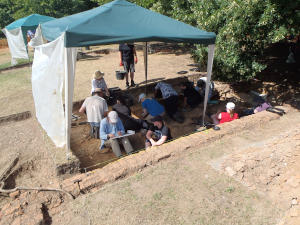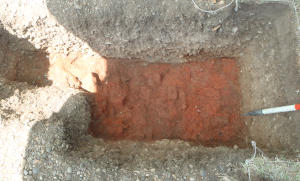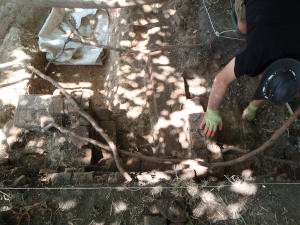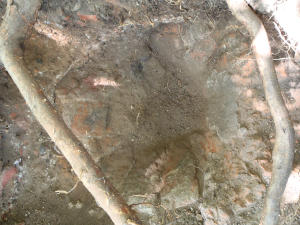23 Jul 2019
Forty Hall Summer Dig - Day 8

It was with some trepidation that we returned to Forty Hall today after our day off yesterday to resume our summer dig on the site of Henry VIII's Elsyng Palace. Weather forecasts are predicting record breaking heat this week and we are anticipating that this may slow us down considerably.
With the help of some tactically strung tarpaulins we were able to provide shade for most of our diggers and with frequent rest and drink breaks we got on with finishing the excavation of the east end of trench 2, and also began drawing the south face of the barn wall.

Meanwhile in trench 1 we excavated more of the crushed brick deposit that we found on day 6, hoping to confirm that it is indeed the remnants of the southern boundary wall of the palace complex.
So far we haven't been able to define any clear edges which might confirm its width or alignment, and the possibility remains that this deposit represents something other than the boundary wall.
Excavation of this feature is particulary difficult and slow going in the 30 plus degree heat, even with the shade of a gazebo, since it lies under about half a metre of highly compacted and sun baked gravel and brickearth.

Conditions at the west end of trench 2 were slightly less opressive under the shade of Forty Hall's famous lime trees, where we continued to excavate the small extension that was opened on day 6 to look at more of the complex brick features at this end of the barn.
On the far side of the wall stub which we uncovered on day 6, we began removing the rubble deposit which covered most of the trench, expecting to define the other side of the wall stub and also more of the barn wall.
We quickly found that the rubble deposit was very deep and looked as if it had a sloping edge, thinking at first it was filling an old tree planting pit for one of the many generations of lime trees that have been planted in Forty Hall's avenue.

To our surprise, we actually found that the sloping edge was brick lined, and eventually we uncovered a very unusual brick lined conical hollow, measuring about 40cm across, the bottom of which had a layer of ash and charcoal and showed signs of intense burning. The sloping face even has a partly surviving rendered face, which looks to be soot-blackened.
Initial analysis of the mortar suggests this feature dates to the Earl of Worcester's occupation of the site in the early to mid 15th century, and along with the other wall fragments probably pre-dates the late 15th/early 16th century barn.
We think it is the base of a fire pit or ash pit, likely used for heating something fairly small, such as a small cauldron. This may confirm the area around the boiling house and the barn were part of Elsyng's complex of kitchen and service ranges long before it became a royal palace.
We've found very few subtantial remains of the house dating from this period, so it's very exciting not only to find in-situ remains like this, but also to be able to add to the development history of the palace, up to a century before it became part of Henry VIII's extensive palace portfolio.
Tomorrow we'll extend this end of the trench again to get a better exposure of this feature and also hopefully see if there's any more of this early phase building surviving nearby.